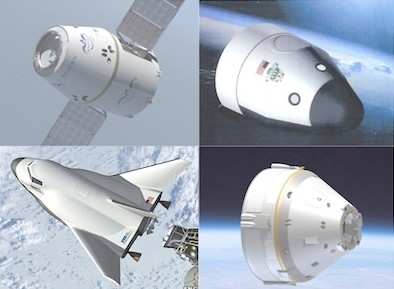Fri, Feb 10, 2012
Blog Post Outlines Progress, NASA Adminstrator's Vision
In an entry posted on a NASA blog, Administrator Charles Bolden
says NASA and its industry partners make tremendous progress on the
commercial capability for delivering cargo and transporting crew to
low Earth orbit (LEO). He says it’s a path that will stop the
out-sourcing of our missions to the space station and bring that
work back home here to America by relying on U.S. companies to get
the job done.

"Our initial investments with the Commercial Orbital
Transportation Services (COTS) program had two participants --
SpaceX and Orbital Sciences -- and our investments are paying off,"
Bolden writes. "From SpaceX's launch, orbit, and successful
recovery of a Dragon capsule in December 2010 to this year's
planned berthing of capsules at the International Space Station
(ISS) by both SpaceX and Orbital, the milestones have been nothing
short of historic.
Bolden says the commercial approach to space transportation has
grown and now features partnerships with a diverse array of
companies, both large and small, each with their own expertise and
innovations. "With the first two Commercial Crew Development rounds
of awards, we've moved forward with partners who are working on
different kinds of space transportation systems technologies -- all
with the aim of providing future robust crew transportation
capabilities for our nation to reach low Earth orbit. We look
forward to more outcomes from these partners and others in the
future.
"Now, we've launched our call for the next phase of our
ambitious program to develop an integrated system for transporting
crew to LEO and potentially astronauts to the ISS. Earlier today,
we released an announcement for proposals that asks U.S. companies
to bring us their best plans to achieve a crewed orbital flight
demonstration by the middle of the decade. The resulting space act
agreement awards will range from $300 - $500 million, and we
anticipate multiple awards.

"Since the dawn of human space flight, private industry has been
a critical partner in building the rockets and spacecraft that have
helped NASA reach higher. But no longer can NASA afford to own and
operate these expensive systems for travel to low Earth orbit. By
handing this work off to U.S. industry, we are freed up to focus on
the more difficult destinations including new missions of the
future to asteroids and Mars. Also, we keep the work of
transporting our astronauts to the ISS here in the United States
and stop the outsourcing of this work to foreign providers.
"The base period of the funded space act agreements of this next
phase of our commercial space program are planned to start in
August of this year and run to May 2014. Along with our ongoing
work on a heavy lift rocket and Orion crew capsule to reach deep
space, a recently graduated class of astronauts and a future class
that has just submitted their preliminary applications, America's
human space flight aspirations - and the hardware to make them
reality -- are going strong."
More News
A Puff Of Smoke Came Out From The Top Of The Engine Cowling Followed By A Total Loss Of Engine Power On May 9, 2025, about 1020 mountain daylight time, an experimental amateur-buil>[...]
From 2022 (YouTube Edition): Jenny, I’ve Got Your Number... Among the magnificent antique aircraft on display at EAA’s AirVenture 2022 was a 1918 Curtiss Jenny painstak>[...]
Very High Frequency (VHF) The frequency band between 30 and 300 MHz. Portions of this band, 108 to 118 MHz, are used for certain NAVAIDs; 118 to 136 MHz are used for civil air/grou>[...]
“From approximately November 2021 through January 2022, Britton-Harr, acting on behalf of AeroVanti, entered into lease-purchase agreements for five Piaggio-manufactured airc>[...]
Microburst A small downburst with outbursts of damaging winds extending 2.5 miles or less. In spite of its small horizontal scale, an intense microburst could induce wind speeds as>[...]
 NTSB Prelim: Lee Aviation LLC JA30 SuperStol
NTSB Prelim: Lee Aviation LLC JA30 SuperStol Classic Aero-TV: Curtiss Jenny Build Wows AirVenture Crowds
Classic Aero-TV: Curtiss Jenny Build Wows AirVenture Crowds ANN's Daily Aero-Term (05.30.25): Very High Frequency (VHF)
ANN's Daily Aero-Term (05.30.25): Very High Frequency (VHF) Aero-News: Quote of the Day (05.30.25)
Aero-News: Quote of the Day (05.30.25) ANN's Daily Aero-Term (05.31.25): Microburst
ANN's Daily Aero-Term (05.31.25): Microburst




